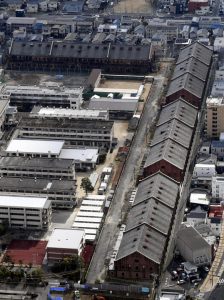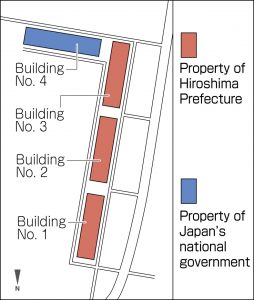Finance minister expresses willingness to take budgetary measures for Army Clothing Depot, opening way for preservation as national cultural property
Jul. 4, 2023
by Koji Higuchi, Staff Writer
On July 3, Japan’s Finance Minister Shunichi Suzuki told Liberal Democratic Party Diet members elected from the A-bombed prefecture that, “We hope to move forward with designating the buildings as cultural properties. Please (have the relevant agencies) submit budget requests,” with respect to the former Army Clothing Depot (Minami Ward), among the largest remaining A-bombed structures in Hiroshima City. Hiroshima Prefecture has been seeking budgetary support for seismic reinforcement work on the structures. With consideration of the prefecture’s aim of having the Army Clothing Depot buildings designated as national important cultural properties, Mr. Suzuki seems to have shown his willingness to take appropriate budgetary measures if requested by Japan’s Cultural Affairs Agency.
The government would subsidize half of the repair costs if the structures were to obtain designation as nationally important cultural properties. According to provisional calculations by the prefecture, it would cost at least 580 million yen for each of the buildings to undergo seismic reinforcement. The structures, which serve as “silent witnesses” to the atomic bombing, were once threatened with demolition by prefectural policy. With financial support from the national government, however, the buildings have a better chance at being preserved.
On the same day, Finance Minister Suzuki met with four members of the LDP parliamentarians’ association to promote relief to A-bomb survivors and the abolition of nuclear weapons. The four members included Minoru Terada, president of the association (representing Hiroshima Prefecture’s District No. 5), and Hiroshi Hiraguchi, the group’s secretary general (Hiroshima Prefecture’s District No. 2). Reporting Mr. Suzuki’s thinking about the issue to reporters after the meeting, Mr. Terada had a positive impression. “The comments from the finance minister will provide a big boost,” he said. The association members will also meet with Keiko Nagaoka, minister of Education, Culture, Sports, Science and Technology, on July 4 to ask for her support.
For designation of national important cultural properties, the Cultural Affairs Agency needs to consult with a committee of experts upon receipt of an application from an owner of the property. In March, Hiroshima Prefecture put together the results of a survey that found three of the four buildings were considered to have significant cultural value. However, the local Chugoku Finance Bureau, which owns the other structure, has not yet announced its plans. That same day, the parliamentarians’ association persuaded Mr. Suzuki of the need to move in step with the prefecture and, according to Mr. Hiraguchi, gained the minister’s understanding.
In early June, Hiroshima Prefectural Governor Hidehiko Yuzaki paid a visit to Prime Minister Fumio Kishida at his official residence in Tokyo to make a direct appeal for financial support to carry out the seismic reinforcement work on the former Army Clothing Depot buildings. A member of Hiroshima Prefecture’s management planning team, which is in charge of the issue, said, "It would be very reassuring if financial support from the national government were to materialize.”
Keywords
Former Army Clothing Depot
The former Army Clothing Depot was a facility once used to manufacture military uniforms and footwear for the former Imperial Japanese Army. The facility buildings, located 2.7 kilometers southeast of the hypocenter, were completed in 1913. After the atomic bomb was dropped, the buildings were used as temporary relief shelters for A-bomb survivors. The depot originally consisted of 13 buildings, but only four, situated in an L-shaped configuration, remained after World War II. They were used as warehouses for private corporations and as a student dormitory for Hiroshima University. Hiroshima Prefecture owns buildings No. 1-3, while building No. 4 is in the possession of Japan’s national government. Now more than 100 years old, the structures are showing signs of significant deterioration.
(Originally published on July 4, 2023)
On July 3, Japan’s Finance Minister Shunichi Suzuki told Liberal Democratic Party Diet members elected from the A-bombed prefecture that, “We hope to move forward with designating the buildings as cultural properties. Please (have the relevant agencies) submit budget requests,” with respect to the former Army Clothing Depot (Minami Ward), among the largest remaining A-bombed structures in Hiroshima City. Hiroshima Prefecture has been seeking budgetary support for seismic reinforcement work on the structures. With consideration of the prefecture’s aim of having the Army Clothing Depot buildings designated as national important cultural properties, Mr. Suzuki seems to have shown his willingness to take appropriate budgetary measures if requested by Japan’s Cultural Affairs Agency.
The government would subsidize half of the repair costs if the structures were to obtain designation as nationally important cultural properties. According to provisional calculations by the prefecture, it would cost at least 580 million yen for each of the buildings to undergo seismic reinforcement. The structures, which serve as “silent witnesses” to the atomic bombing, were once threatened with demolition by prefectural policy. With financial support from the national government, however, the buildings have a better chance at being preserved.
On the same day, Finance Minister Suzuki met with four members of the LDP parliamentarians’ association to promote relief to A-bomb survivors and the abolition of nuclear weapons. The four members included Minoru Terada, president of the association (representing Hiroshima Prefecture’s District No. 5), and Hiroshi Hiraguchi, the group’s secretary general (Hiroshima Prefecture’s District No. 2). Reporting Mr. Suzuki’s thinking about the issue to reporters after the meeting, Mr. Terada had a positive impression. “The comments from the finance minister will provide a big boost,” he said. The association members will also meet with Keiko Nagaoka, minister of Education, Culture, Sports, Science and Technology, on July 4 to ask for her support.
For designation of national important cultural properties, the Cultural Affairs Agency needs to consult with a committee of experts upon receipt of an application from an owner of the property. In March, Hiroshima Prefecture put together the results of a survey that found three of the four buildings were considered to have significant cultural value. However, the local Chugoku Finance Bureau, which owns the other structure, has not yet announced its plans. That same day, the parliamentarians’ association persuaded Mr. Suzuki of the need to move in step with the prefecture and, according to Mr. Hiraguchi, gained the minister’s understanding.
In early June, Hiroshima Prefectural Governor Hidehiko Yuzaki paid a visit to Prime Minister Fumio Kishida at his official residence in Tokyo to make a direct appeal for financial support to carry out the seismic reinforcement work on the former Army Clothing Depot buildings. A member of Hiroshima Prefecture’s management planning team, which is in charge of the issue, said, "It would be very reassuring if financial support from the national government were to materialize.”
Keywords
Former Army Clothing Depot
The former Army Clothing Depot was a facility once used to manufacture military uniforms and footwear for the former Imperial Japanese Army. The facility buildings, located 2.7 kilometers southeast of the hypocenter, were completed in 1913. After the atomic bomb was dropped, the buildings were used as temporary relief shelters for A-bomb survivors. The depot originally consisted of 13 buildings, but only four, situated in an L-shaped configuration, remained after World War II. They were used as warehouses for private corporations and as a student dormitory for Hiroshima University. Hiroshima Prefecture owns buildings No. 1-3, while building No. 4 is in the possession of Japan’s national government. Now more than 100 years old, the structures are showing signs of significant deterioration.
(Originally published on July 4, 2023)









